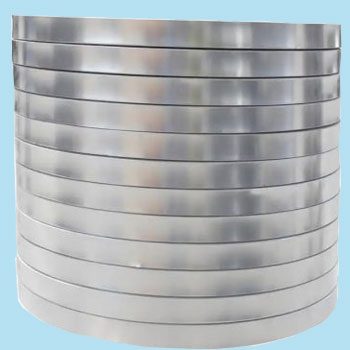Aluminum copolymer tape
Products description
- Quality control :under ISO standards and RoHS compliant.
- HS code :7607.20
- Structure:AL-coplymer ,Copolymer-AL-Copolymer (PE or EAA )
- Peel Strength between aluminum tape and coating, more 4N/cm
- Length: 1000meters or 2000meters per roll
- (ID):2"(52mm), 3"(76mm) ,6"(152mm)
- Application:used as moisture-proof layer, Shield layer of communication cable, fiber cable ,power cable and other cable.
Technical parameters
| Structure | Thickness(μm) | Density(g/m2) | Yield(m2/kg) |
| 150AL+50PE | 190~210 | 455.5 | 2.2 |
| 200AL+50PE | 240~260 | 591 | 1.7 |
| 50PE+150AL+50PE | 240~260 | 504.5 | 2.0 |
| 50PE+200AL+50PE | 290~310 | 640 | 1.6 |
Tensile strength>50MPA; Elongation at break >18%
Handle temperature: min 160℃ ,during this degree ,the copolymer pe film is adhesive which can be the tapes stick to the cable conduct and jacket.
Aluminum coated copolymer tape include single-sided aluminum copolymer tape, double-sided aluminum copolymer tape which are made of alloy aluminum coated copolymer PE film and then slitting it to different width With length 1050m or 2100m per rolls . The standard specifications are 150AL+50PE,200AL+50PE,50PE+150AL+50PE, 50PE+200AL+50PE. It can be done in green color ,blue color ,and natural colors
First as a conductive material, aluminum copolymer tape is used as a protective layer in armored cables. It can protect the entire power cable structure, prevent termites, mice and other pests, and it can effectively transmit and distribute current to ensure the normal operation of the power system. Due to its good electrical conductivity and lower cost, the use of aluminum copolymer tapes can reduce overall manufacturing costs and improve product performance.
Secondly the aluminum copolymer tape has excellent corrosion resistance too. When used in outdoor environments or wet conditions, however, aluminum copolymer tapes can effectively prevent metal parts from being easily oxidized and corroded .
Storage:In room temperature . Keep dry away from light direct irradiation,pollution and all kinds of mechanical outside force.
Aluminum copolymer tape, available in structures such as AL150/PE50, PE50/AL150/PE50, AL200/PE50, and PE50/AL200/PE50, is widely used in cable armoring applications. This tape is composed of an aluminum foil layer bonded with a special polyethylene (PE) copolymer film, offering excellent mechanical strength and adhesion to various cable sheathing materials. The aluminum layer provides outstanding barrier and shielding properties, while the copolymer enhances bonding during cable extrusion processes.
These multi-layer structures are designed to meet different cable protection needs: the AL150 and AL200 options offer varying levels of aluminum thickness for enhanced durability and shielding, while single or double-sided PE50 copolymer layers ensure strong adhesion and compatibility with polyethylene jackets. Aluminum copolymer tape is especially effective in protecting cables from moisture, chemicals, and mechanical damage, making it ideal for use in power, control, and communication cables, especially in harsh or buried environments.
This tape plays a crucial role in reinforcing cable structures, improving overall performance, and extending service life by providing an extra layer of shielding and physical protection.
Aluminum copolymer tape in the armored cable provides many advantages for the protection and enhancement of the cable. Aluminum bands combine the high conductivity of aluminum and the flexibility and corrosion resistance of copolymer polyester films. In the armored cable, the aluminum layer provides excellent electromagnetic shielding effect, ensuring the stable transmission of signals inside the cable, while the copolymer polyester layer enhances the waterproof, moisture resistance and chemical corrosion resistance of the cable. , Non-viscous aluminum copolymer tape also has good mechanical strength and wear resistance. In the cable armor layer, it can effectively resist the external physical damage and wear, and protect the cable from mechanical damage. This protection capability makes the cable more safe and more reliable during transportation, installation and use.

